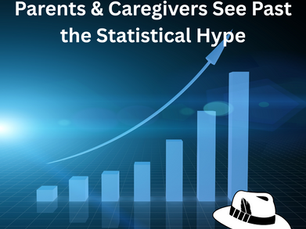top of page


Banning Tylenol and Technology: A Lesson In The Oversimplification Of Research
When fear meets complexity, bans often feel like the easiest fix. But history shows that blunt prohibitions rarely solve nuanced problems. Just as the Tylenol - autism debate oversimplifies medical risks, calls to ban phones and social media from kids risk ignoring both evidence and opportunity. Parents and schools need balance, not bans, to truly protect and prepare youth.

The White Hatter
Sep 254 min read


Sorting Fact from Fear - Helping Parents & Caregivers See Past the Statistical Hype
A viral bar graph claims screens, sleep, and work swallow nearly all of life, leaving almost no free time. Eye-catching? Yes. Accurate? Not at all. With no data, no citations, and exaggerated numbers, it’s designed to alarm, not inform. Using real Canadian research, we show why parents shouldn’t panic over hype-driven graphics and instead focus on balance, purpose, and evidence.

The White Hatter
Sep 224 min read


Contrary To What Some In Our Industry Say, Parents and Caregivers CAN Compete With Big Tech!
Parents are not powerless against Big Tech. Despite billion-dollar budgets and endless algorithms, research shows that kids don’t just absorb content, they interpret it through the conversations, examples, and guidance they get at home. Your presence and influence shape how they see the online world. Big Tech may capture their eyes, but you shape their understanding.

The White Hatter
Sep 215 min read


“6,7” and the Language of Gen Alpha
What does ‘6,7’ mean?” That’s the question teachers and parents across the country are asking as Gen Alpha turns a random lyric into a cultural code. It’s slang, identity, and sometimes defiance, all rolled into two numbers. To understand it is to glimpse how music and internet culture shape youth language today

The White Hatter
Sep 192 min read


Algorithms, Outrage, Radicalization, and Raising Resilient Kids in an Increasingly Online Polarized World
Why do the loudest and most extreme voices dominate our kids’ social media feeds? It isn’t by accident, it’s by design. Algorithms reward outrage because anger drives clicks, shares, and profit. The danger is that teens may mistake these amplified extremes for everyday reality. Parents must help them see past the noise, build resilience, and find strength in the middle ground.

The White Hatter
Sep 145 min read


Hopelessness and Frustration: Catalysts in the Metastasis of Radicalization
Why are some young people drawn toward extremism? At The White Hatter, after decades of listening to teens, one theme keeps surfacing: hopelessness. When doors to housing, education, jobs, and even healthcare feel locked, frustration can deepen into despair. Left unchecked, that despair can make youth more vulnerable to radical voices. Hope, and being heard , are critical safeguards

The White Hatter
Sep 134 min read


Talking to Our Kids About Violence, Radicalization, and the Role of Social Media
When violent tragedies unfold, social media doesn’t just report, it amplifies. Graphic videos, conspiracy theories, and polarizing narratives spread within hours, creating fertile ground for those who want to recruit and radicalize youth. No family is immune. Parents need to step in with open, honest conversations that help kids process emotions, spot manipulation, and know they’re not alone.

The White Hatter
Sep 124 min read


Social Media, Kids, Parents, and Accountability vs. Responsibility
Think your child is too young for social media? Chances are, they’re already on it. Studies from Canada, the U.S., Australia, and Ireland all say the same thing: huge numbers of kids under 13 have accounts, often set up with a parent’s help. That means the conversation can’t stop at blaming tech companies, it has to include the choices we make at home as a parent or caregiver

The White Hatter
Sep 74 min read


What Parents Should Know About This Stealerium Malware Story
A new type of malware named “Stealerium” is being used by cybercriminals in highly invasive attacks. (1) It doesn’t just grab passwords or financial info, it actively watches for pornography searches or browsing. When it detects such content, it secretly takes screenshots of the browser and snaps a photo of the user via their webcam. All this data is then sent to criminals who can use it to blackmail victims.

The White Hatter
Sep 62 min read


Snapchat’s New “Home Safe” Feature: What Parents Need to Know
Worried about your teen getting home safely? Snapchat’s new Home Safe feature automatically alerts a trusted friend when they arrive at their set home location. It’s a one-time notification designed to balance safety with independence, no constant tracking, just peace of mind. Here’s how it works, plus tips for parents on using it wisely.

The White Hatter
Sep 23 min read
bottom of page
